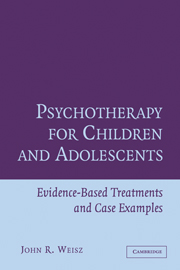Book contents
- Frontmatter
- Contents
- Preface
- SECTION A GENERAL INTRODUCTION
- SECTION B TREATMENTS FOR FEARS AND ANXIETY
- Introduction to Section B: The Case of Sean and Treatments for Fears and Anxiety
- 2 Four Classic Treatments for Fears: Modeling, Systemic Desensitization, Reinforced Exposure, and Self-Talk
- 3 Therapies for Anxiety Disorders: Coping Cat, Coping Koala, and Family Anxiety Management
- SECTION C TREATMENTS FOR DEPRESSION
- SECTION D TREATMENTS FOR ATTENTION DEFICIT/HYPERACTIVITY DISORDER
- SECTION E TREATMENTS FOR CONDUCT PROBLEMS AND CONDUCT DISORDER
- SECTION F CONCLUSION
- References
- Author Index
- Subject Index
3 - Therapies for Anxiety Disorders: Coping Cat, Coping Koala, and Family Anxiety Management
Published online by Cambridge University Press: 06 July 2010
- Frontmatter
- Contents
- Preface
- SECTION A GENERAL INTRODUCTION
- SECTION B TREATMENTS FOR FEARS AND ANXIETY
- Introduction to Section B: The Case of Sean and Treatments for Fears and Anxiety
- 2 Four Classic Treatments for Fears: Modeling, Systemic Desensitization, Reinforced Exposure, and Self-Talk
- 3 Therapies for Anxiety Disorders: Coping Cat, Coping Koala, and Family Anxiety Management
- SECTION C TREATMENTS FOR DEPRESSION
- SECTION D TREATMENTS FOR ATTENTION DEFICIT/HYPERACTIVITY DISORDER
- SECTION E TREATMENTS FOR CONDUCT PROBLEMS AND CONDUCT DISORDER
- SECTION F CONCLUSION
- References
- Author Index
- Subject Index
Summary
Most of the evidence-based treatments for youth anxiety are focused interventions targeting specific fears. However, some youngsters develop more complex and pervasive clusters of fears and patterns of avoidance, coalescing in ways that meet all the diagnostic criteria for a formal DSM anxiety disorder. In the disorder called social phobia, for example, youngsters fear embarrassment or humiliation, and they avoid a variety of social or performance situations where they think others will be watching or evaluating them. With social phobia, children may fear speaking in public, playing a team sport, or even eating or writing in school for fear that others will see their hands shake. Separation anxiety disorder involves excessive anxiety from home or from people to whom the child is attached. In generalized anxiety disorder, boys and girls experience excessive anxiety and worry more days than not about multiple events and activities, often related to concerns about their own competence or the quality of their performance (e.g., in schoolwork and social activities).
Building on ideas discussed in the section introduction and in Chapter 2 in relation to specific fears, many in the field also take a multifactor view of anxiety disorder etiology – a view that includes biological, cognitive, and behavioral elements. On the biological front, individuals with anxiety disorders show hypersensitivity to stress and challenge, and a diffuse stress response, probably involving multiple neurobiological systems (see e.g., Albano et al., 1996). The biological stress response is linked to anxiety-elevating cognitions or self-talk (e.g., “I know I'll screw up”) and to behavioral avoidance of the stressors.
- Type
- Chapter
- Information
- Psychotherapy for Children and AdolescentsEvidence-Based Treatments and Case Examples, pp. 65 - 98Publisher: Cambridge University PressPrint publication year: 2004



